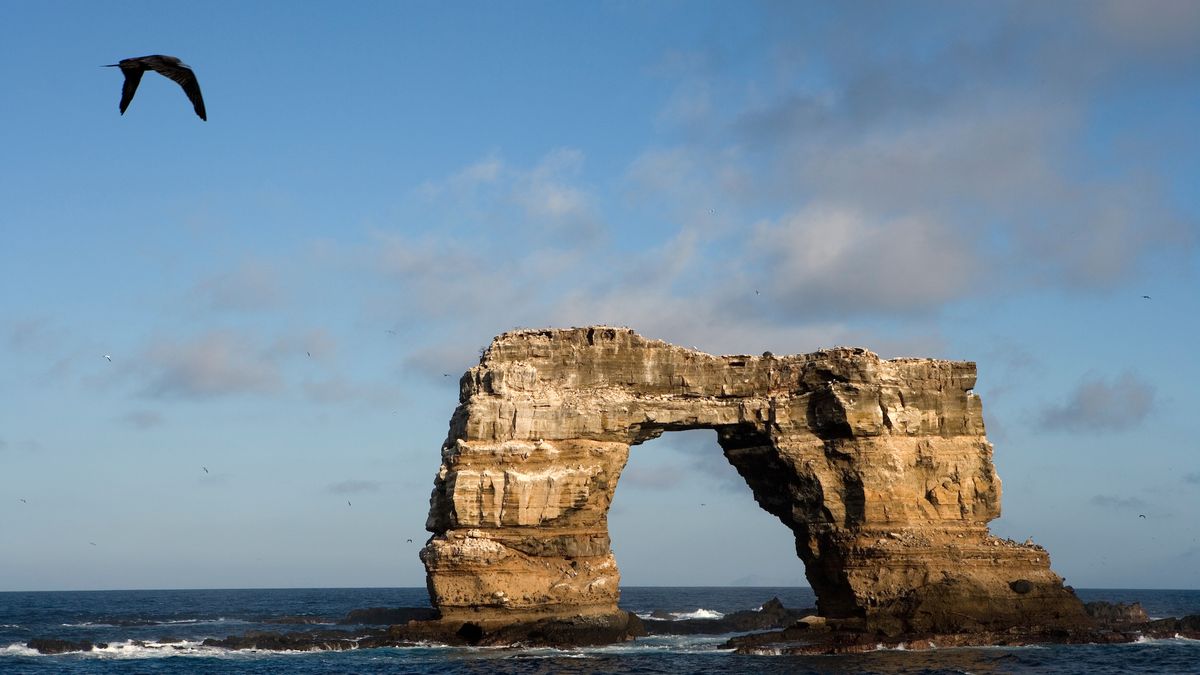
The top of Darwin's Arch, the famous natural stone archway in the northern Galapagos Islands, has crashed into the waves, according to news reports.
The arch, located less than 0.6 miles (1 kilometer) off the steep and rocky coast of Darwin Island, collapsed as "a consequence of natural erosion," on May 17, the Ecuador Ministry of Environment and Water wrote in Spanish on Twitter.
The natural arch was named for the English biologist Charles Darwin, who studied evolution in the Galapagos during his voyage aboard the HMS Beagle in the early 1830s. Now that the arch's top is gone, one tour company, Aggressor Adventures, is calling the two stone monoliths that remain "The Pillars of Evolution," CNN reported.
Related: Channel Islands: Photos of North America's Galapagos
Darwin Island is a volcanic island that sits on a rocky platform about 32 feet (10 meters) underwater, according to a 2014 study in the journal PLOS One. This platform extends to the southeast, where Darwin's Arch once sat. The ministry noted in a second tweet that, "at one point [the arch] would have been part of Darwin Island," presumably referring to when sea levels were lower.
The platform holding the island and the arch descends into a steep slope that goes down more than 328 feet (100 m), according to the PLOS One study.
While tourists could never catch a glimpse of the arch from the land — Darwin Island is not open to visitors — the waters off its coast are open, and are "considered one of the best places on the planet to dive and observe schools of sharks and other species," the ministry wrote in its second tweet.
Informamos que hoy 17 de mayo, se reportó el colapso del Arco de Darwin, el atractivo puente natural ubicado a menos de un kilómetro de la isla principal Darwin, la más norte del archipiélago de #Galápagos. Este suceso sería consecuencia de la erosión natural. 📷Héctor Barrera pic.twitter.com/lBZJWNbgHgMay 17, 2021
And in fact, the PLOS One study found that pregnant whale sharks (Rhincodon typus) made "intense use of Darwin's Arch."
Previous research had shown that the waters around the arch were "home to an extraordinarily high density of multiple species of sharks and other reef and pelagic [open ocean] fish that change on a seasonal basis," the team wrote in the study. This includes hammerheads and other sharks, sea turtles, manta rays and dolphins, according to the Galapagos Conservancy.
But while the researchers knew that whale sharks, the largest known living fish, often swam around Darwin Island, they were still surprised that four pregnant whale sharks (being tracked with acoustic tags) frequented the arch, even though the sharks weren't eating or showing any specific behaviors there.
The team concluded that Darwin Island has a role "as an important stopover in a migration, possibly with reproductive purposes," for whale sharks.
The Galapagos Marine Reserve was designated to protect sea life, and the Galapagos' 19 islands are also recognized as a World Heritage site by the United Nations Educational, Scientific and Cultural Organization (UNESCO). The islands won't look the same without the arch, but hopefully the whale sharks won't mind.
Originally published on Live Science.
The Link LonkMay 19, 2021 at 08:40PM
https://ift.tt/2T4SWYb
Iconic 'Darwin's Arch' in the Galapagos has crashed into the sea - Livescience.com
https://ift.tt/2CoSmg4
Sea
/cloudfront-us-east-2.images.arcpublishing.com/reuters/CZF6NULMVVMEXHOP7JK5BSPQUM.jpg)
No comments:
Post a Comment